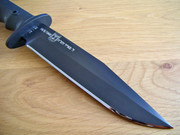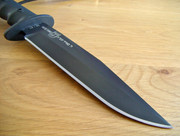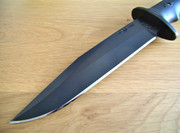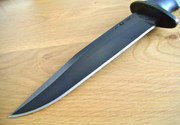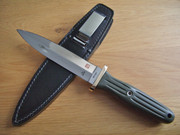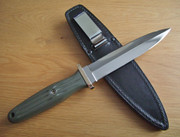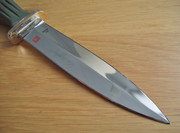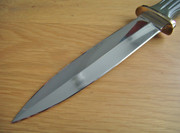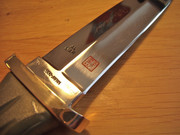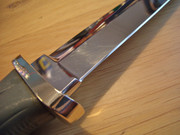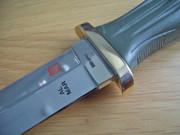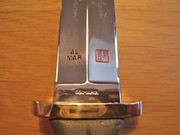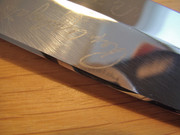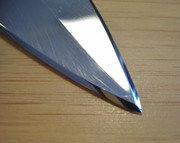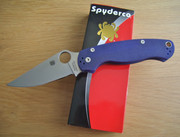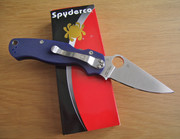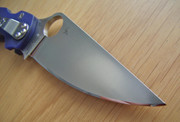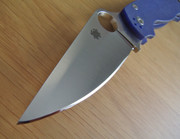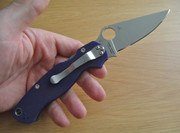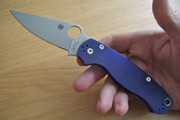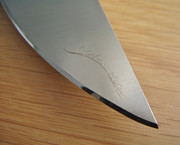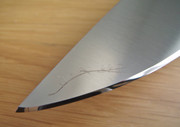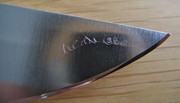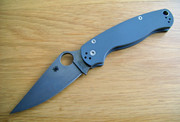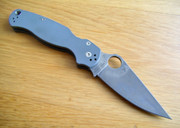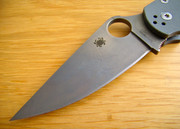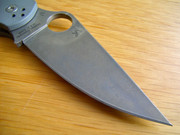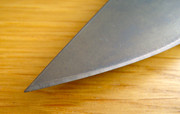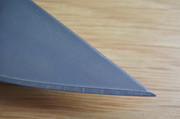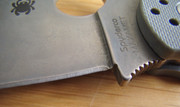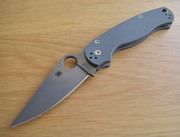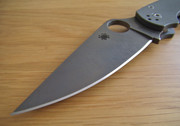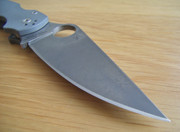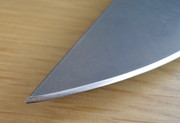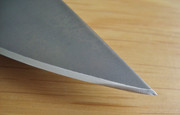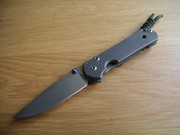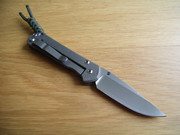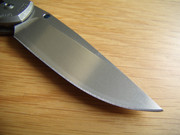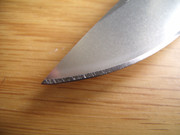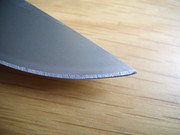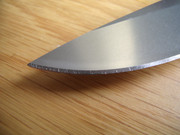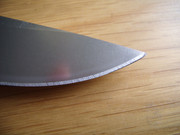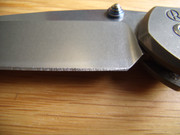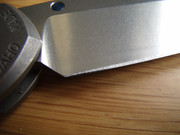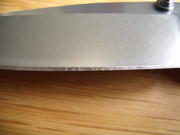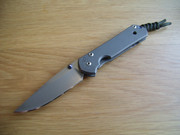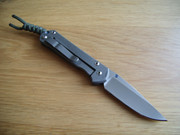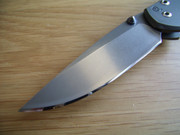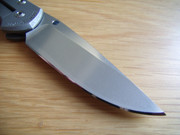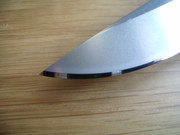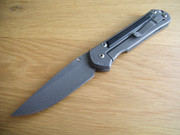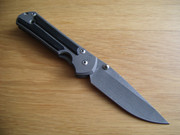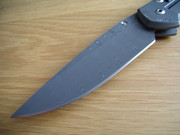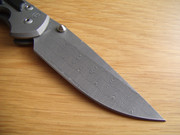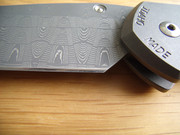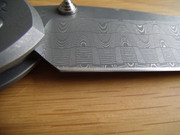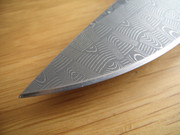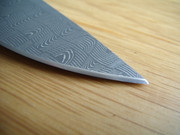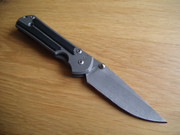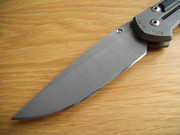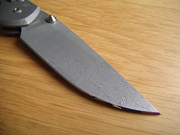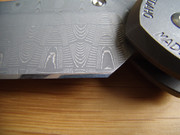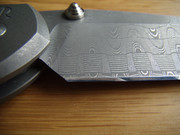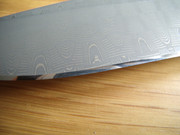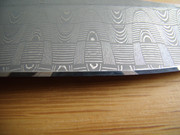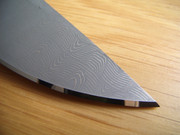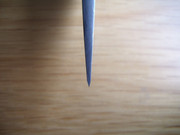See Page 1, Post 8
Show your Paper Wheel edges
-
-
after a bit of reading, it just a usual MDF piece, you can buy in any Baumarkt

-
They are similar, but not the same.
There are differences in base materials, in weight, and in the hardness of the surfaces.At this point in time i have no hands-on experience with MDF for this particular method of motorized sharpening (only for hand strops), but a member of British Blades passed on a warning to me that he received from an English company specializing in polishing equipment, that in the professional world home-made MDF Wheels are considered too dangerous to use.
It seems that they can come apart suddenly due to the centrifugal forces most benchgrinders can create. -
Dustar Model 1 Arad 67 Commemorative combat knife from a collector.
The factory "edge" was very rough and also still had a burr so thick that i could lift the entire knife from the table by hooking it with my finger nail.
Edge angle was +/- 45 degrees inclusive which i left intact as the customer did not want wider bevels.
After grinding the apex flat on the Tormek Blackstone the edge was resharpened on a Paper Wheel with 15 micron diamond compound then deburred with a second Paper Wheel with 3 micron diamond compound, an the new edge can just treetop the hairs on the back of my hand.
Probably the most wear resistant D2 steel i have sharpened so far. -
This vintage Al Mar Applegate Fairbairn dagger from a display collection had factory edges which were rather coarse, had a few flat spots, and a flattened point.
Since the "R" from Rex Applegate's signature was already quite close to the +/- 50 degrees inclusive factory edge i chose not to reprofile but instead just polish the existing bevels a bit with successively 15.0 micron, 3.0 micron, and 1.0 micron diamond compound on dedicated Paper Wheels.
Both new edges can shave the hair on the back of my hand on skin level.
( click each pic 2 x for a bit more detail) -
Another PM2 in S110V.
The new edge was done on a Paper Wheel with 15 micron diamond compound, and then refined with 6.0 micron, 3.0 micron, and 1.0 micron diamond compound, all on dedicated Paper Wheels.
The apex is keen enough to whittle several curls in a row on one of my chest hairs while holding the hair at the root end only.
You can click each pic 2 X for a bit more detail. -
The owner of this Maxamet PM2 had given his knife a forced patina treatment, and besides coming out a bit uneven the acid had also completely eaten away the factory apex as well as the very tip of the blade.
To say that the knife was completely blunt would have been an understatement.
The request was to give the knife a new toothy edge with a lot of bite while making it as sharp as possible.
(You can click each pic 2 X for a bit more detail)Before sharpening:
After sharpening
Flattened the acid damaged "apex" some more on a 3000 grit diamond plate so i could start with fresh steel, then made a new edge on a Rubber Wheel coated with +/- 230 grit diamond powder & wax, then deburred on a Paper Wheel with 1.0 micron diamond paste & oil.
The new edge is ever so slightly convex, the new apex fits almost exactly in the 30 degree inclusive slot of my Tormek WM200 Angle Master, plus it can whittle one of my chest hairs at about 5.5 centimeters from the point of holding. (i don't own a BESS tester)
The somewhat "fuzzy" shoulders of the new edge show how deep the acid has eaten away into the sides of the blade in some area's. -
Those edges look gorgeous.
However, I wonder whether the blades get hot while you sharp them. An often used argument against belt grinders is that the blade will get hot and that this will affect the hardening of the blade.
-
And it's a very valid argument i can tell you.
That is also why my Wheels have a coating of cooling wax or oil on top of the abrasive so overheating will not happen.
Something i know for sure as i test every edge i sharpen this way afterwards by cutting several times into a testing block and measuring sharpness before & after testing. -
Right hand Takamura R2 Gyuto 210 mm from a local Chef, who got it as a birthday present from his wife.
The knife has already been used for two months in the commercial kitchen and it was time for it's first resharpening, which i did yesterday on a Paper Wheel with 15 micron diamond compound and then deburred on a second Paper Wheel with 0.25 micron diamond compound.
The idea was to make an edge that would do both slicing & pushcutting well, and also to remove as little steel as possible from the fine and thin R2/SG2 blade @ 63-64 HRC.
The new edge measures +/- 20 degrees inclusive and can whittle a chest hair from root-to-tip at about 4 centimeters from the point of holding, and after a few test cuts into a old piece of beechwood cutting board.I took these pics with an old Ipad and actually wanted to erase them again as being not good enough until i enlarged the last picture twice.
At first i thought i saw small dirt spots on the new bevel, but those tiny white specks were actually the sliced off peaks of the micro-dot structure on the inside of the flimsy plastic blade protector sleeve. -
The owner of the Takamura R2 just sent me the link to this clip, in which he uses a grape to test the new edge:
-
Update on the Takamura R2 210 Gyuto:
According to the Chef this edge done on Paper Wheels lasted him 2 months in his commercial kitchen, which was just as long as the factory edge had lasted him.
During that time he sometimes touched up the edge by stropping it on an MDF strop with 1.0 micron diamond compound until that no longer worked satisfactory (in the last week or so), after which he used a fine ceramic rod on it.
Differences with the factory edge were that the Paper Wheel edge had a slightly smaller edge angle (+/- 20 degrees inclusive instead of +/- 22,5 degrees inclusive), was finer polished, and had a higher sharpness.We're still in the process of finetuning the edge to his specific requirements, and next time he brings in the knife it will probably get a little less refined edge to see if it's useful life can be prolonged a bit more.
In his kitchen the real edge killers are the mandatory plastic cutting boards which are very abrasive on knife edges, together with the almost unavoidable tiny sand particles which sometimes remain in the huge quantities of vegetables that need to be processed. -
Italian made A.G.A Campolin Maltese stiletto from a collector.
The knife was recently bought brand new from a foreign shop, but it came with quite a lot of blade play, a very rough ~55 degrees inclusive "edge" with a big burr still attached to it, and no point at all.
Also both sides of the blade aren't mirror images of each other, with a center ridge that is off a bit on one side.
Anyway, especially the lack of a point bothered the owner, the bad edge came in second, and fixing the blade play will probably be a job for another day.
This is how the knife looked before resharpening:And how the knife looks now.
While keeping the edge angle about the same so the bevels would not widen too much per owner's request, i resharpened the main edge completely and the bayonet grind only superficially to come to a sharp point with a 15 micron diamond compound Paper Wheel, then cleaned up the bevels a bit and removed the tiny burr with a 1.0 micron diamond compound Paper Wheel.
The edge angle again measures ~55 degrees inclusive, yet the new apex is just sharp enough to shave the hair on the back of my hand a bit on skin level. -
Another nice work from you. Looks very goog. Thanks for showing!
-
The first owner of this small Sebenza apparently thought it a good idea to use the knife for sharpening practice in his new Wicked Edge.
The outcome made him sell the knife for a measly 150 Euro's to owner number two, who sent it to me with the request to tidy things up a bit and give it a bit of a shiny edge.Below is what the knife looked like when i received it, still with it's very rough and partly unapexed "edge", and with an edge angle of ~40 degrees inclusive at the straight part of the edge, changing into ~45 degrees inclusive from belly to point.
-
After reprofiling & sharpening on a Paper Wheel with 15 micron diamond compound, then deburring and polishing it a bit with a second Paper Wheel coated with 1.0 micron diamond compound.
The new edge is a bit convex, and measures ~30 degrees inclusive on the straight part of the edge, changing into ~35 degrees inclusive from belly to point.
This to avoid widening the bevels there too much, as this blade is relatively thick behind the edge in that area.
The last picture shows a small facet at the heel which has an entirely different angle, so i could not remove it without making things worse.
Visually it's not perfect yet treetopping sharp, and the owner was happy. -
Nice work! :hatsoff:
-
User LH Sebenza Micarta with it's blade made from Devin Thomas stainless basketweave damascus (AEB-L and 304)
Reprofiled & sharpened the old slightly convex edge with it's apex @ ~40 degrees inclusive into a new slightly convex edge with an apex @ ~30 degrees inclusive on a Paper Wheel with 15 micron diamond compound, then removed the extremely fine burr on a piece of copypaper with a dab of 0.25 micron diamond paste.
The new apex is reverse chest hair whittling sharp and the new point is also quite close to being centered again.
To my functioning eye the bevels look near-mirror like, but the camera sees a bit blotchy scratch pattern due to the different layers in the damascus steel.Before:
After:
-
For people using diamond compounds on Paper Wheels like i do; give Nano-Oil 5 weight a try.
I have been using this oil exclusively for quite a few years now, and so far it's the best i've come across.
It remains speculation if that is because of the special "fullerene" additives or something else entirely, but it seems to make the diamond particles cut cleaner than anything else i've experimented with.
Certain steels like ZDP-189 and S35VN come off the 15 micron diamond compound wheel completely burr-free and ready to use, which is something i've never been able to do with any other oil type.
Jetzt mitmachen!
Sie haben noch kein Benutzerkonto auf unserer Seite? Registrieren Sie sich kostenlos und nehmen Sie an unserer Community teil!

